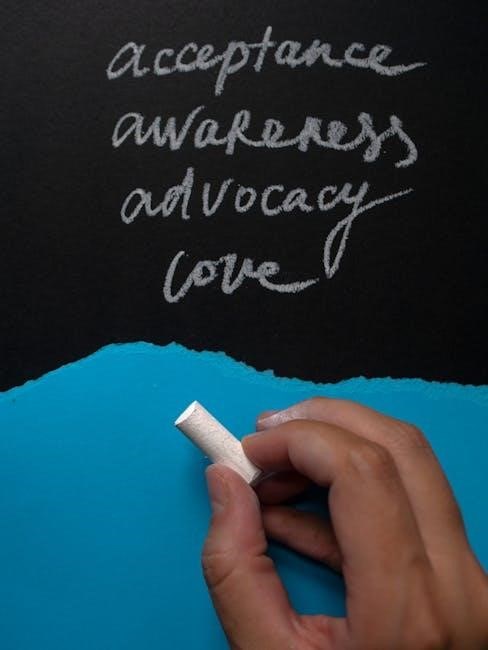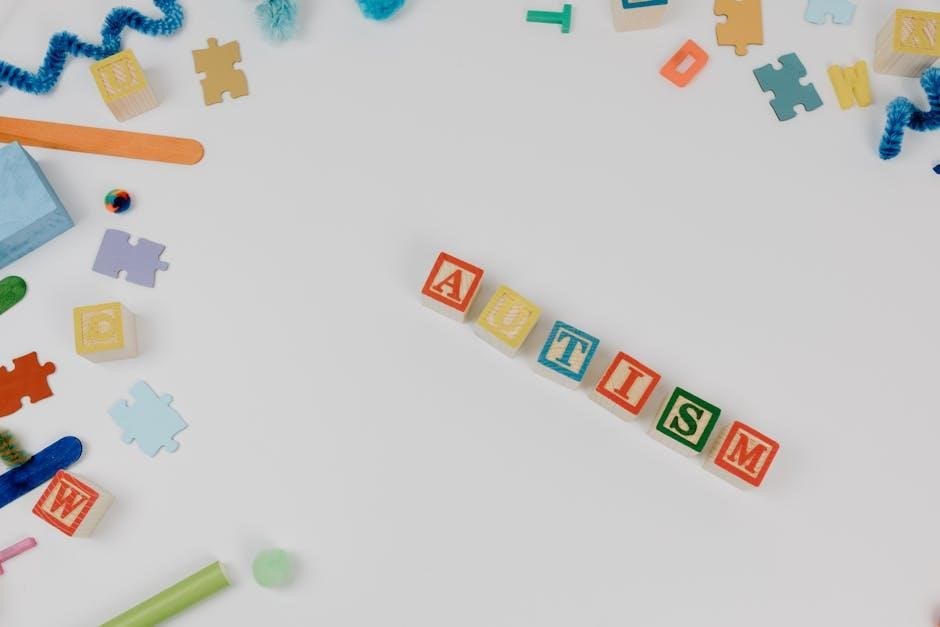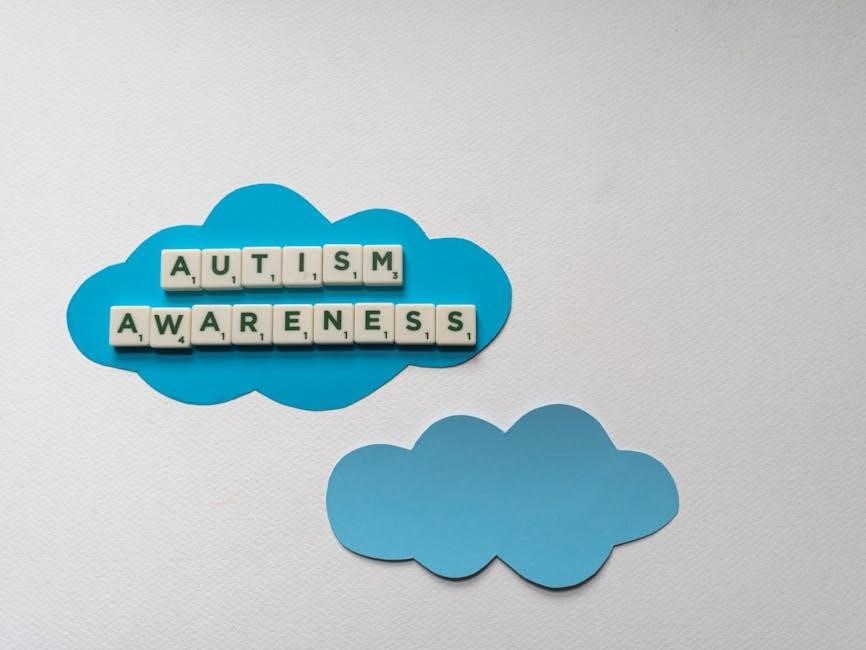Effective communication is vital for individuals with autism, addressing challenges through strategies like visual aids and tailored approaches to enhance interaction, empowerment, and daily understanding.
1.1 Understanding the Importance of Communication in Autism
Communication is a cornerstone of human interaction, particularly for individuals with autism, as it directly impacts their ability to express needs, emotions, and ideas. Effective communication strategies are essential for fostering social connections, reducing misunderstandings, and enhancing daily living experiences. They play a critical role in addressing challenges such as verbal and non-verbal barriers, enabling individuals with autism to navigate their environment confidently. By prioritizing communication support, we empower autistic individuals to participate fully in society, build meaningful relationships, and achieve greater independence.
1.2 Overview of Common Communication Challenges in Autism
Individuals with autism often face significant communication challenges, including difficulties with verbal and non-verbal expression, social interactions, and interpreting cues. Many experience barriers in initiating or maintaining conversations, understanding sarcasm, or recognizing emotional tone. Some may rely on repetitive language or struggle with eye contact. Sensory sensitivities can also complicate communication, as overwhelming environments may hinder interaction. These challenges vary widely among individuals, emphasizing the need for personalized approaches to address unique needs and enhance overall communication abilities.

Visual Communication Strategies

Visual communication strategies, such as pictures, symbols, and social stories, provide effective tools to bridge communication gaps in autistic individuals, enhancing understanding and expression.

2.1 Using Pictures and Symbols for Effective Communication
Using pictures and symbols is a proven strategy to support communication in autistic individuals. These visual aids help bridge gaps by making abstract concepts concrete. They reduce anxiety and provide a clear means of expression. Visual tools like schedules and choice boards enhance predictability and independence. Consistency is key, as familiar symbols help individuals understand expectations. Tailoring symbols to individual preferences and developmental levels maximizes effectiveness. This approach fosters independence, reduces frustration, and creates a supportive environment for meaningful interaction and learning.
2.2 Implementing Social Stories to Aid Understanding
Social stories are a powerful tool to help autistic individuals understand social situations and behaviors. They use simple narratives and visual supports to explain complex social cues. By breaking down interactions into clear, predictable steps, social stories reduce anxiety and improve comprehension. Tailored to individual needs, they address specific challenges like sharing, initiating conversations, or responding to emotions. Consistent review of these stories in a calm environment enhances their effectiveness, fostering confidence and positive social interactions. They are particularly beneficial for addressing routine changes or unexpected events;

Verbal and Non-Verbal Communication Approaches
Combining verbal and non-verbal strategies supports autistic individuals in expressing needs and emotions. Techniques like visual aids and tailored approaches enhance understanding and foster meaningful interactions consistently.

3.1 Enhancing Verbal Communication Skills in Autistic Individuals

Enhancing verbal communication in autistic individuals involves tailored strategies like using visual aids and reinforcement techniques. Structured environments and clear instructions help build confidence. Modeling language and encouraging interactions through shared interests can foster progress. Incorporating technology, such as iPads, provides engaging tools for practice. Consistency, patience, and positive reinforcement are key to fostering verbal expression and understanding, ensuring each individual can communicate effectively and participate fully in daily activities.
3.2 Leveraging Non-Verbal Cues and Gestures
Non-verbal cues and gestures are essential for supporting communication in autistic individuals. Strategies such as using hand gestures, facial expressions, and visual aids like pictures or symbols can enhance understanding and expression. Ensuring consistent and patient interaction allows individuals to process information effectively. Clear body language and supportive environments help reduce misunderstandings. By leveraging these non-verbal methods, communication becomes more accessible and meaningful.

Augmentative and Alternative Communication (AAC) Methods
AAC methods, like PECS and high-tech devices, empower individuals with autism to express needs and thoughts, offering consistency and support tailored to their unique communication requirements.
The Picture Exchange Communication System (PECS) is a widely used AAC method designed to help individuals with autism communicate effectively. It involves using pictures or symbols to initiate communication, allowing users to express their needs, wants, and thoughts. PECS is particularly beneficial for non-verbal or minimally verbal individuals, as it provides a structured and systematic approach to communication. By teaching individuals to exchange pictures for desired items or activities, PECS fosters independence and confidence in communication, making it a valuable tool for enhancing daily interactions and quality of life.
4.2 Exploring High-Tech AAC Devices and Apps
High-tech AAC devices and apps offer advanced communication solutions for individuals with autism. These tools utilize text-to-speech, predictive text, and customizable vocabulary to meet diverse needs; Apps like Proloquo2Go and Tobii Dynavox enable users to create personalized communication boards, while devices such as iPads with AAC software provide portability and accessibility. These technologies empower individuals to express complex thoughts and emotions, fostering independence and confidence. Regular updates and advancements ensure these tools remain relevant, making them invaluable for enhancing communication in various settings, from home to school and beyond.
Environmental Modifications to Support Communication
Creating a calm, organized space with minimal distractions and sensory-friendly adjustments supports effective communication. Strategic use of visual aids and noise reduction tools enhances interaction and focus.
5;1 Creating a Conducive Communication-Friendly Environment
A supportive environment plays a crucial role in fostering effective communication for autistic individuals. Strategies include using visual aids, structured layouts, and sensory-friendly adjustments. Reducing sensory stimulants, such as loud noises or harsh lighting, helps minimize discomfort. Incorporating noise-reducing tools and natural lighting can create a calm atmosphere. Organizing physical spaces to promote focus and engagement is essential. These modifications enable individuals with autism to process information more effectively, fostering clearer and more meaningful interactions. A well-designed environment encourages confidence and participation, laying the foundation for improved communication skills and social engagement.
5.2 Reducing Sensory Overload to Enhance Interaction
Creating a sensory-friendly environment is critical for effective communication. Autistic individuals often experience sensory overload, which can hinder interaction. Strategies like using noise-canceling headphones, dimmable lighting, and comfortable seating can reduce sensory stress. Minimizing background noise and avoiding strong odors or bright lights also helps. These adjustments create a calming atmosphere, allowing individuals to focus better and engage more readily. By addressing sensory needs, communication becomes more accessible and meaningful, fostering a supportive and inclusive interaction environment.

Personalized Communication Plans
Personalized communication plans focus on individual needs, preferences, and strengths, ensuring tailored strategies that foster meaningful interactions and support unique learning styles for autistic individuals effectively.
6.1 Developing Tailored Strategies for Individuals with Autism
Developing tailored strategies involves assessing individual needs, preferences, and strengths to create personalized approaches. This includes incorporating visual aids, structured routines, and communication tools that align with the person’s learning style. Caregivers and educators collaborate to design interventions that promote engagement and independence. Strategies are regularly reviewed and adjusted to reflect growth and changing needs, ensuring they remain effective and relevant. This individualized approach fosters meaningful communication and supports overall development, empowering autistic individuals to express themselves confidently and participate fully in various settings.
6.2 Incorporating Preferences and Interests in Communication Plans
Incorporating preferences and interests into communication plans enhances engagement and motivation. Using topics or activities the individual enjoys as themes for communication tools can increase participation. Visual aids and structured resources aligned with their interests help create meaningful interactions. This personalized approach fosters trust and confidence, making communication more effective and enjoyable. Regularly updating these strategies ensures they remain relevant and impactful, supporting the individual’s unique needs and promoting overall development effectively.

Training and Support for Caregivers and Educators
Comprehensive guides and resources provide practical advice and strategies for caregivers and educators, helping them support autistic individuals in communicating effectively.
7.1 Educating Parents and Teachers on Effective Communication Strategies
Educating parents and teachers on effective communication strategies is crucial for supporting autistic individuals. Training programs often emphasize the use of visual aids, social stories, and structured routines to enhance understanding. These strategies help caregivers and educators create a consistent and supportive environment. Additionally, training focuses on promoting active listening, patience, and positive reinforcement. By learning these methods, parents and teachers can better adapt their communication styles to meet the unique needs of autistic individuals, fostering clearer and more meaningful interactions. This education empowers caregivers to address challenges effectively while encouraging open dialogue and emotional connection.
7.2 Building a Supportive Community for Autistic Individuals
Building a supportive community for autistic individuals involves fostering inclusivity and understanding. Collaboration between parents, educators, and professionals is essential to create environments that promote acceptance and belonging. Community programs, such as social groups and sensory-friendly events, can help autistic individuals connect and thrive. By raising awareness and providing accessible resources, communities can empower autistic individuals to engage meaningfully. Encouraging open dialogue and inclusive practices ensures that everyone’s needs are met, fostering a culture of respect and empathy that benefits all members of society.